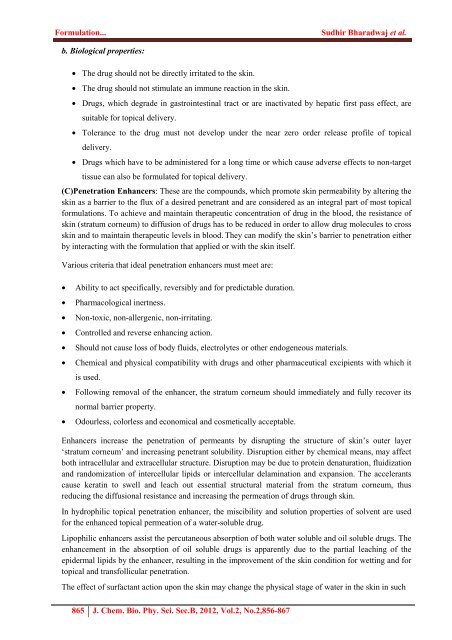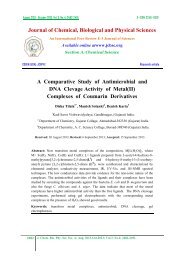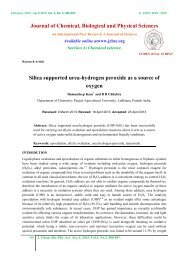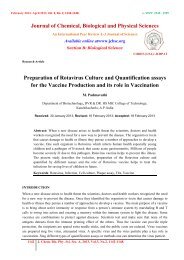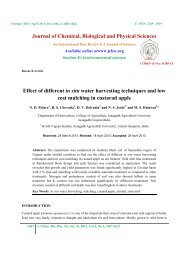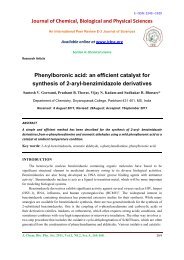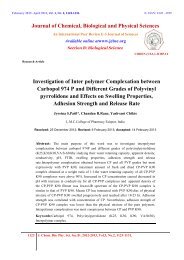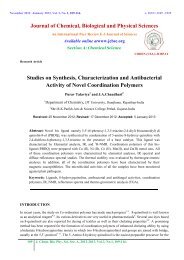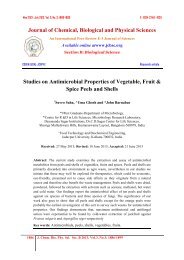Topical Gel: A Novel approach for drug delivery - Journal of ...
Topical Gel: A Novel approach for drug delivery - Journal of ...
Topical Gel: A Novel approach for drug delivery - Journal of ...
- No tags were found...
You also want an ePaper? Increase the reach of your titles
YUMPU automatically turns print PDFs into web optimized ePapers that Google loves.
Formulation...Sudhir Bharadwaj et al.b. Biological properties:• The <strong>drug</strong> should not be directly irritated to the skin.• The <strong>drug</strong> should not stimulate an immune reaction in the skin.• Drugs, which degrade in gastrointestinal tract or are inactivated by hepatic first pass effect, aresuitable <strong>for</strong> topical <strong>delivery</strong>.• Tolerance to the <strong>drug</strong> must not develop under the near zero order release pr<strong>of</strong>ile <strong>of</strong> topical<strong>delivery</strong>.• Drugs which have to be administered <strong>for</strong> a long time or which cause adverse effects to non-targettissue can also be <strong>for</strong>mulated <strong>for</strong> topical <strong>delivery</strong>.(C)Penetration Enhancers: These are the compounds, which promote skin permeability by altering theskin as a barrier to the flux <strong>of</strong> a desired penetrant and are considered as an integral part <strong>of</strong> most topical<strong>for</strong>mulations. To achieve and maintain therapeutic concentration <strong>of</strong> <strong>drug</strong> in the blood, the resistance <strong>of</strong>skin (stratum corneum) to diffusion <strong>of</strong> <strong>drug</strong>s has to be reduced in order to allow <strong>drug</strong> molecules to crossskin and to maintain therapeutic levels in blood. They can modify the skin’s barrier to penetration eitherby interacting with the <strong>for</strong>mulation that applied or with the skin itself.Various criteria that ideal penetration enhancers must meet are:• Ability to act specifically, reversibly and <strong>for</strong> predictable duration.• Pharmacological inertness.• Non-toxic, non-allergenic, non-irritating.• Controlled and reverse enhancing action.• Should not cause loss <strong>of</strong> body fluids, electrolytes or other endogeneous materials.• Chemical and physical compatibility with <strong>drug</strong>s and other pharmaceutical excipients with which itis used.• Following removal <strong>of</strong> the enhancer, the stratum corneum should immediately and fully recover itsnormal barrier property.• Odourless, colorless and economical and cosmetically acceptable.Enhancers increase the penetration <strong>of</strong> permeants by disrupting the structure <strong>of</strong> skin’s outer layer‘stratum corneum’ and increasing penetrant solubility. Disruption either by chemical means, may affectboth intracellular and extracellular structure. Disruption may be due to protein denaturation, fluidizationand randomization <strong>of</strong> intercellular lipids or intercellular delamination and expansion. The accelerantscause keratin to swell and leach out essential structural material from the stratum corneum, thusreducing the diffusional resistance and increasing the permeation <strong>of</strong> <strong>drug</strong>s through skin.In hydrophilic topical penetration enhancer, the miscibility and solution properties <strong>of</strong> solvent are used<strong>for</strong> the enhanced topical permeation <strong>of</strong> a water-soluble <strong>drug</strong>.Lipophilic enhancers assist the percutaneous absorption <strong>of</strong> both water soluble and oil soluble <strong>drug</strong>s. Theenhancement in the absorption <strong>of</strong> oil soluble <strong>drug</strong>s is apparently due to the partial leaching <strong>of</strong> theepidermal lipids by the enhancer, resulting in the improvement <strong>of</strong> the skin condition <strong>for</strong> wetting and <strong>for</strong>topical and transfollicular penetration.The effect <strong>of</strong> surfactant action upon the skin may change the physical stage <strong>of</strong> water in the skin in such865 J. Chem. Bio. Phy. Sci. Sec.B, 2012, Vol.2, No.2,856-867


